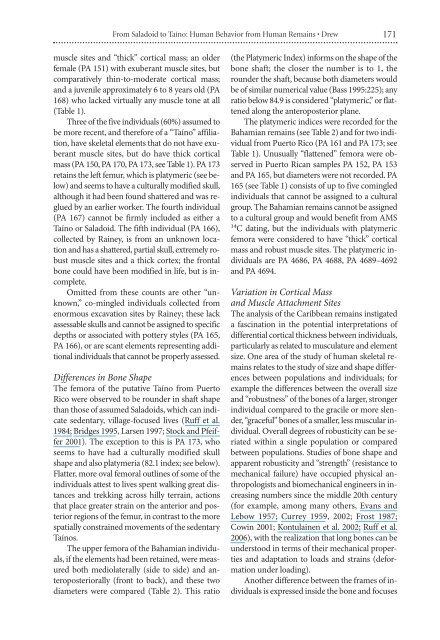Create successful ePaper yourself
Turn your PDF publications into a flip-book with our unique Google optimized e-Paper software.
<strong>From</strong> <strong>Saladoid</strong> <strong>to</strong> <strong>Taíno</strong>: <strong>Human</strong> <strong>Behavior</strong> <strong>from</strong> <strong>Human</strong> <strong>Rema<strong>in</strong>s</strong> • Drew 171<br />
muscle sites and “thick” cortical mass; an older<br />
female (PA 151) with exuberant muscle sites, but<br />
comparatively th<strong>in</strong>-<strong>to</strong>-moderate cortical mass;<br />
and a juvenile approximately 6 <strong>to</strong> 8 years old (PA<br />
168) who lacked virtually any muscle <strong>to</strong>ne at all<br />
(Table 1).<br />
Three of <strong>the</strong> five <strong>in</strong>dividuals (60%) assumed <strong>to</strong><br />
be more recent, and <strong>the</strong>refore of a “<strong>Taíno</strong>” affiliation,<br />
have skeletal elements that do not have exuberant<br />
muscle sites, but do have thick cortical<br />
mass (PA 150, PA 170, PA 173, see Table 1). PA 173<br />
reta<strong>in</strong>s <strong>the</strong> left femur, which is platymeric (see below)<br />
and seems <strong>to</strong> have a culturally modified skull,<br />
although it had been found shattered and was reglued<br />
by an earlier worker. The fourth <strong>in</strong>dividual<br />
(PA 167) cannot be firmly <strong>in</strong>cluded as ei<strong>the</strong>r a<br />
<strong>Taíno</strong> or <strong>Saladoid</strong>. The fifth <strong>in</strong>dividual (PA 166),<br />
collected by Ra<strong>in</strong>ey, is <strong>from</strong> an unknown location<br />
and has a shattered, partial skull, extremely robust<br />
muscle sites and a thick cortex; <strong>the</strong> frontal<br />
bone could have been modified <strong>in</strong> life, but is <strong>in</strong>complete.<br />
Omitted <strong>from</strong> <strong>the</strong>se counts are o<strong>the</strong>r “unknown,”<br />
co-m<strong>in</strong>gled <strong>in</strong>dividuals collected <strong>from</strong><br />
enormous excavation sites by Ra<strong>in</strong>ey; <strong>the</strong>se lack<br />
assessable skulls and cannot be assigned <strong>to</strong> specific<br />
depths or associated with pottery styles (PA 165,<br />
PA 166), or are scant elements represent<strong>in</strong>g additional<br />
<strong>in</strong>dividuals that cannot be properly assessed.<br />
Differences <strong>in</strong> Bone Shape<br />
The femora of <strong>the</strong> putative <strong>Taíno</strong> <strong>from</strong> Puer<strong>to</strong><br />
Rico were observed <strong>to</strong> be rounder <strong>in</strong> shaft shape<br />
than those of assumed <strong>Saladoid</strong>s, which can <strong>in</strong>dicate<br />
sedentary, village-focused lives (Ruff et al.<br />
1984; Bridges 1995, Larsen 1997; S<strong>to</strong>ck and Pfeiffer<br />
2001). The exception <strong>to</strong> this is PA 173, who<br />
seems <strong>to</strong> have had a culturally modified skull<br />
shape and also platymeria (82.1 <strong>in</strong>dex; see below).<br />
Flatter, more oval femoral outl<strong>in</strong>es of some of <strong>the</strong><br />
<strong>in</strong>dividuals attest <strong>to</strong> lives spent walk<strong>in</strong>g great distances<br />
and trekk<strong>in</strong>g across hilly terra<strong>in</strong>, actions<br />
that place greater stra<strong>in</strong> on <strong>the</strong> anterior and posterior<br />
regions of <strong>the</strong> femur, <strong>in</strong> contrast <strong>to</strong> <strong>the</strong> more<br />
spatially constra<strong>in</strong>ed movements of <strong>the</strong> sedentary<br />
<strong>Taíno</strong>s.<br />
The upper femora of <strong>the</strong> Bahamian <strong>in</strong>dividuals,<br />
if <strong>the</strong> elements had been reta<strong>in</strong>ed, were measured<br />
both mediolaterally (side <strong>to</strong> side) and anteroposteriorally<br />
(front <strong>to</strong> back), and <strong>the</strong>se two<br />
diameters were compared (Table 2). This ratio<br />
(<strong>the</strong> Platymeric Index) <strong>in</strong>forms on <strong>the</strong> shape of <strong>the</strong><br />
bone shaft; <strong>the</strong> closer <strong>the</strong> number is <strong>to</strong> 1, <strong>the</strong><br />
rounder <strong>the</strong> shaft, because both diameters would<br />
be of similar numerical value (Bass 1995:225); any<br />
ratio below 84.9 is considered “platymeric,” or flattened<br />
along <strong>the</strong> anteroposterior plane.<br />
The platymeric <strong>in</strong>dices were recorded for <strong>the</strong><br />
Bahamian rema<strong>in</strong>s (see Table 2) and for two <strong>in</strong>dividual<br />
<strong>from</strong> Puer<strong>to</strong> Rico (PA 161 and PA 173; see<br />
Table 1). Unusually “flattened” femora were observed<br />
<strong>in</strong> Puer<strong>to</strong> Rican samples PA 152, PA 153<br />
and PA 165, but diameters were not recorded. PA<br />
165 (see Table 1) consists of up <strong>to</strong> five com<strong>in</strong>gled<br />
<strong>in</strong>dividuals that cannot be assigned <strong>to</strong> a cultural<br />
group. The Bahamian rema<strong>in</strong>s cannot be assigned<br />
<strong>to</strong> a cultural group and would benefit <strong>from</strong> AMS<br />
14C dat<strong>in</strong>g, but <strong>the</strong> <strong>in</strong>dividuals with platymeric<br />
femora were considered <strong>to</strong> have “thick” cortical<br />
mass and robust muscle sites. The platymeric <strong>in</strong>dividuals<br />
are PA 4686, PA 4688, PA 4689–4692<br />
and PA 4694.<br />
Variation <strong>in</strong> Cortical Mass<br />
and Muscle Attachment Sites<br />
The analysis of <strong>the</strong> Caribbean rema<strong>in</strong>s <strong>in</strong>stigated<br />
a fasc<strong>in</strong>ation <strong>in</strong> <strong>the</strong> potential <strong>in</strong>terpretations of<br />
differential cortical thickness between <strong>in</strong>dividuals,<br />
particularly as related <strong>to</strong> musculature and element<br />
size. One area of <strong>the</strong> study of human skeletal rema<strong>in</strong>s<br />
relates <strong>to</strong> <strong>the</strong> study of size and shape differences<br />
between populations and <strong>in</strong>dividuals; for<br />
example <strong>the</strong> differences between <strong>the</strong> overall size<br />
and “robustness” of <strong>the</strong> bones of a larger, stronger<br />
<strong>in</strong>dividual compared <strong>to</strong> <strong>the</strong> gracile or more slender,<br />
“graceful” bones of a smaller, less muscular <strong>in</strong>dividual.<br />
Overall degrees of robusticity can be seriated<br />
with<strong>in</strong> a s<strong>in</strong>gle population or compared<br />
between populations. Studies of bone shape and<br />
apparent robusticity and “strength” (resistance <strong>to</strong><br />
mechanical failure) have occupied physical anthropologists<br />
and biomechanical eng<strong>in</strong>eers <strong>in</strong> <strong>in</strong>creas<strong>in</strong>g<br />
numbers s<strong>in</strong>ce <strong>the</strong> middle 20th century<br />
(for example, among many o<strong>the</strong>rs, Evans and<br />
Lebow 1957; Currey 1959, 2002; Frost 1987;<br />
Cow<strong>in</strong> 2001; Kontula<strong>in</strong>en et al. 2002; Ruff et al.<br />
2006), with <strong>the</strong> realization that long bones can be<br />
unders<strong>to</strong>od <strong>in</strong> terms of <strong>the</strong>ir mechanical properties<br />
and adaptation <strong>to</strong> loads and stra<strong>in</strong>s (deformation<br />
under load<strong>in</strong>g).<br />
Ano<strong>the</strong>r difference between <strong>the</strong> frames of <strong>in</strong>dividuals<br />
is expressed <strong>in</strong>side <strong>the</strong> bone and focuses


















